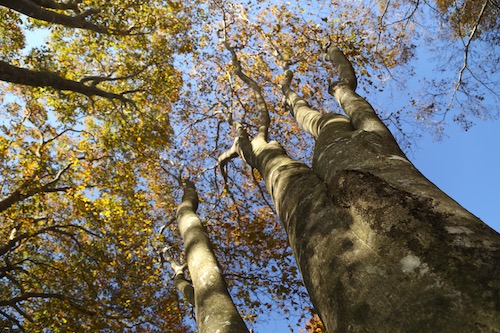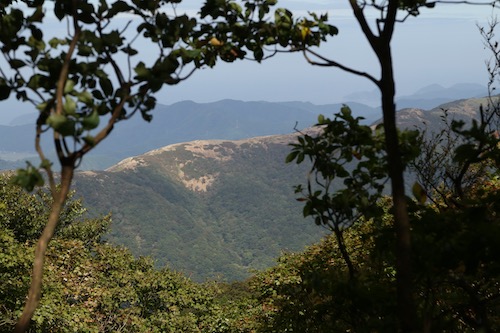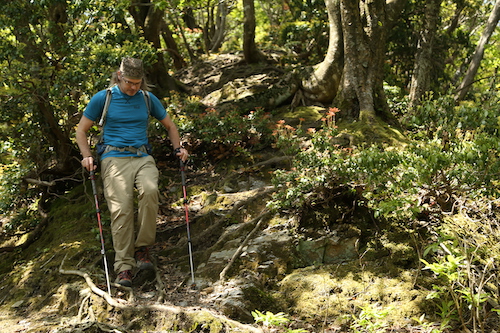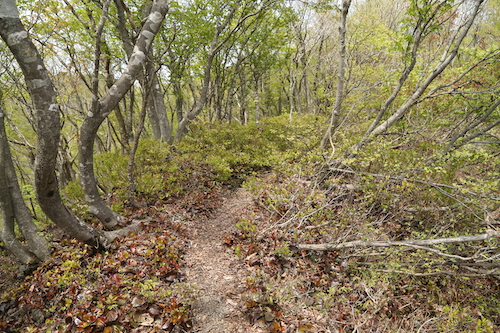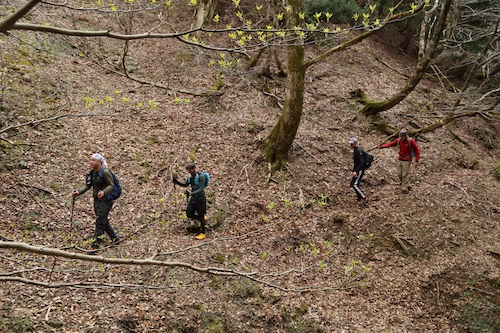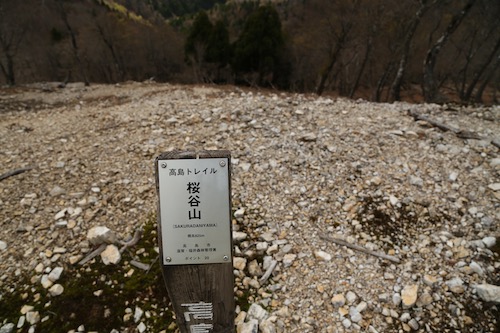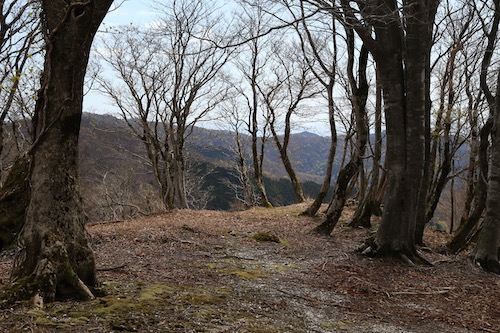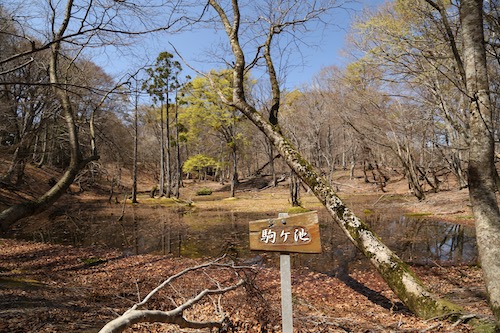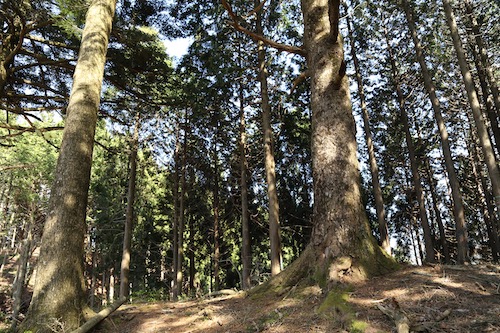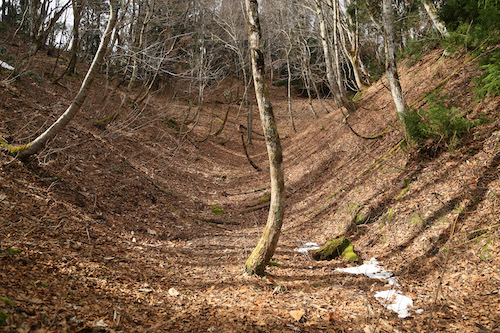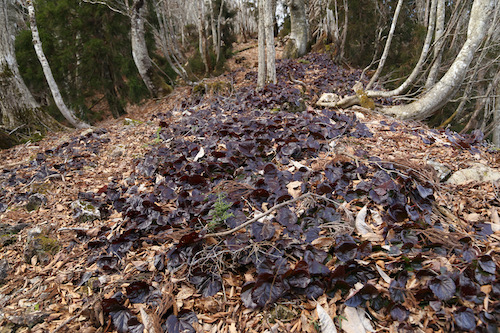As we edge closer to Makino and the end of our 80km section hike, Ted and I study the weather forecasts and research about the current state of the forest road to Nukedo. We are perhaps just one heavy rain away from the road being lost to landslides, so time is of the essence. Late October and the stage is set, with a high-pressure system and a rare family-free weekend providing a much-needed catalyst. Ted points the car north on route 367 before shooting northwest into Fukui Prefecture and past the port town of Obama. Further east, after skirting the edge of Mihama city, Ted navigates the impossibly twisted switchbacks above the Mimi river as we finally reach the full parking lot of Nukedo where we last left the Takashima. It seems that we are not the only ones out to take advantage of the autumn weather.

A group of school kids loiter at one of two trails leading skyward toward Ōtaniyama. The leader prepares to take them up the Mihama trail, so we scoot past and opt for the proper Takashima route running through neighboring Shiga Prefecture. We shoot off at a brisk pace, eager to reach the top of the spur ahead of the elementary-aged children. Dew glistens off the trees as we make our way up the shaded eastern slopes. The rising sun penetrates through gaps in the dense forest canopy, illuminating the brilliant autumn foliage in its seasonal amber hues.

The Takashima leads us up a narrow spur through a kingdom of healthy hardwoods. For a change of scenery, I ask Ted about his fledgling career as a part-time method actor, for which he willingly enlightens me about his time on the set of the 2009 indie film Tengu.

The world of acting is one field I have yet to explore, unless you count a pair of appearances in long-forgotten TV commercials, an obscure music video, and an awkward interview on MUSIC EDGE, so I listen with perked ears as he provides a few titillating behind-the-scenes tidbits that make us forget about the steep climb at hand. Not only do we stay ahead of the school group, we make it nearly to the edge of the summit ridge before the squawks of a large troupe of macaques interrupt our Hollywood reverie. The primates stay out of sight, preferring the shaded depths of a steep valley on our left, but cries grow fainter just as we break out of the forest onto a massive network of rolling ridges of golden grasses and low-lying shrubbery.

What a welcome sight to behold as I scream for delight like a hyperactive child at the county fair. As much as I love a hardwood forest, there’s nothing like hiking on an open ridge with expansive panoramic views. Mt Ibuki sits due east, across the Maya blue waters of Japan’s largest freshwater lake. North of Ibuki, folds of foreshortened ridges in neighboring Gifu prefecture span the horizon, while the mighty Hakusan lies hidden behind a haze of cloud. Light winds coax us along on the gentle inclines to the summit of Ōtaniyama (8), where we glimpse our first unobstructed views of Mt Akasaka sitting on the far end of the oblong ridge. A track drops off here to the south for a couple of hours to the outskirts of Makino. This is the track we were originally planning to take on Day 6 of our hike before giving in to fatigue and an easier escape route back to our car. It has taken us a little over an hour from our car in Nukedo, and with the weather on our side, we pause here for a quick mid-morning snack while savoring the views.

The track drops abruptly straight down the northwestern face of Ōtani’s bulbous edifice, through swaths of Japanese pampas grass dancing gracefully in the breeze. The bright sun sends us scrambling for the sunglasses as we drop toward a narrow col dotted with gnarled hardwoods. To our right, seemingly directly below us, we stare straight down into the sprawling campground of Makino Kogen, our intended starting point for Day 8 if our current hike goes according to plan.
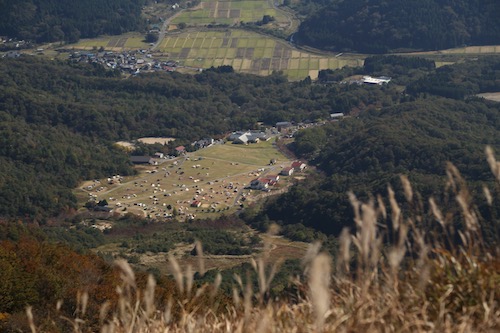
Golden foliage set against the deep blue of the autumn skies sends a smile through my face. Turning around, I see the same countenance spread across Ted’s content face as we silently share our delight at being blessed with that elusive tozan byori, or perfect hiking weather. The Makino range has a bit of a reputation for foul summer weather and blustery wintry blizzards that attract only the foolhardy. Long switchbacks take us through the radiant autumnal hues of the mixed hardwoods and up to the summit of the minor peak of Kanpū (7), providing a striking contrast to the snow-smothered scenery that I had experienced during my first visit here just 8 months prior.

We take in the expansive views while soaking up the rays of the sun, our legs stretched across the small gravel strewn throughout the broad plateau. With the paper map spread between us, we find ourselves with just a 2.5km hike to our turnaround point at Awagaragoe. It seems easy on paper, but one glance to the northeast reveals that we have our work cut out for us.

Dropping steeply down the northern face of Kanpū, the track takes us through a tunnel of twisted beech and onto gentler slopes carpeted with soft grasses leading to to the top of a rise revealing a ridge of rolling slopes. Ted and I spy the summit of Mt Akasaka at the end of this roller coaster of a ridge and it looks deceptively far. Beyond, on an entirely different ridge line, lies the elongated summit of Mt Norikura, the final peak on the Takashima Trail that taunts us like a rival, waving its finger as if to prove that finishing the trail today is an impossibility. We can only hope that this stable high pressure system gives us a chance to complete our goal before the first snowfalls of winter.

While easy to follow, the route hardly takes us in a straight line, instead it opts to hug the ridge tightly as it weaves in and out between forested hillocks and grasslands fit for bovines. We passing up and over a series of unnamed summits, and with each passing peak comes the realization that we will need to re-climb all of these peaks on our return to the car. I mean, we could turn left at Awagaragoe and drop down the old Wakasa Kaidō and loop back to the car. The problem with that is that it would add an extra 10km to our already long hike and it would involve walking up the forest road back to the car. Much better to stay on the ridge, even if it means retracing our steps.

At the top of the third rise in the ridge, we run into an elderly man involved in trail maintenance work. The gentleman informs us that he works for the Takashima tourism bureau and is in charge of promoting the Takashima Trail. We tell him that we are nearly 7/8 the way through our reverse section-hike as we boast about the incredible scenery on the Kyoto section of the trail. “Oh, I haven’t been that far,” he explains rather sheepishly. That is hardly surprising, as his only concern is with bringing money to his fiefdom of Makino instead of promoting the trail as a neutral 3rd-party observer. That’s the problem with tourism agencies across Japan, who are reticent to promote areas in neighboring prefectures as they don’t receive their share of the money if tourists go there. While the Edo era is long gone, feudalism in Japan remains a stronghold in many aspects of society.
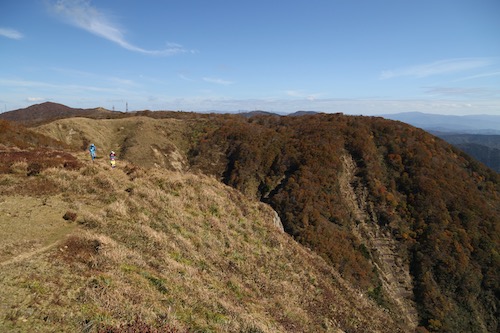
It takes us an additional 20 minutes along the pleasant ridge to reach the first of a series of unsightly electrical pylons built to transport electricity from Mihama Nuclear Power Plant to the urban cities of the Kansai region. You can’t hike far in Japan without coming across either a forest road or an electrical pylon, and the Takashima has delivered both. We pass under the monstrous towers, with their low hum providing a drone-like rhythm to our measured footfalls. It is just after nigh noon when we reach Awagaragoe (6) and the first of the crowds ascending from the popular weekend playground of Makino Kōgen. In a rocky niche above the mountain pass sits a weather-beaten carving of the three-headed Hayagriva, apparently erected there to protect the horses that were traditionally used to carry travelers up and over the mountain pass.

With absolutely no impressive view to speak of, Ted and I decide to carry on a further 500 meters to the summit of Mt Akasaka (5) for a well-deserved lunch break. Before departing for the summit, I put on my Aladdin hat in an attempt at some Halloween humor that immediately backfires among the throngs of day trippers basking in the sunshine. They probably all think that I’m wearing it as a fashion accessory and even Ted starts calling me Lawrence in homage to the Seven Pillars of Wisdom.

After lunch I ditch the costume and we start our long retreat back to the car. I guess one advantage of doing an up-and-back is that the lighting is always changing and the shadows grow deeper as the sun moves further west. We decide to push it as far as we can before taking a break, hoping to get off the mountain before dark when the nocturnal creatures awake for the evening. Indeed, the way back seems to take just a fraction of the time, with the hardest part of the climb coming as we push up the headwall just below the summit of Ōtani and run into a group of two-dozen hikers just starting their descent. On the summit, a pair of hikers don helmets and appear to be loitering on the summit for an unknown reason.

Five minutes into our descent, we discover the reason for the loitering as they set sail in their paragliding gear, swooping out above the rolling plains of Makino. Perhaps paragliding is illegal in these parts, or maybe they were just waiting for the winds to work in their favor. Either way, it is a sight to behold and provides just the change to the scenery that we are needing. As our legs turn to jelly, the rock formation sitting at the far edge of the plateau provides us the perfect place for our final break. I break out the cappuccino energy gels as Ted breaks into a fit of hysterical laughter over someone or something named cougar. We are both giddy from the exhaustion but let those waves of guffawing wash over us as we finally muster up the energy to get back on our feet and stumble the last hour back to the car. With just one final section of the Takashima remaining, we keep an eye on the weather patterns and turn to some familiar companionship to help escort us across the finish line.
